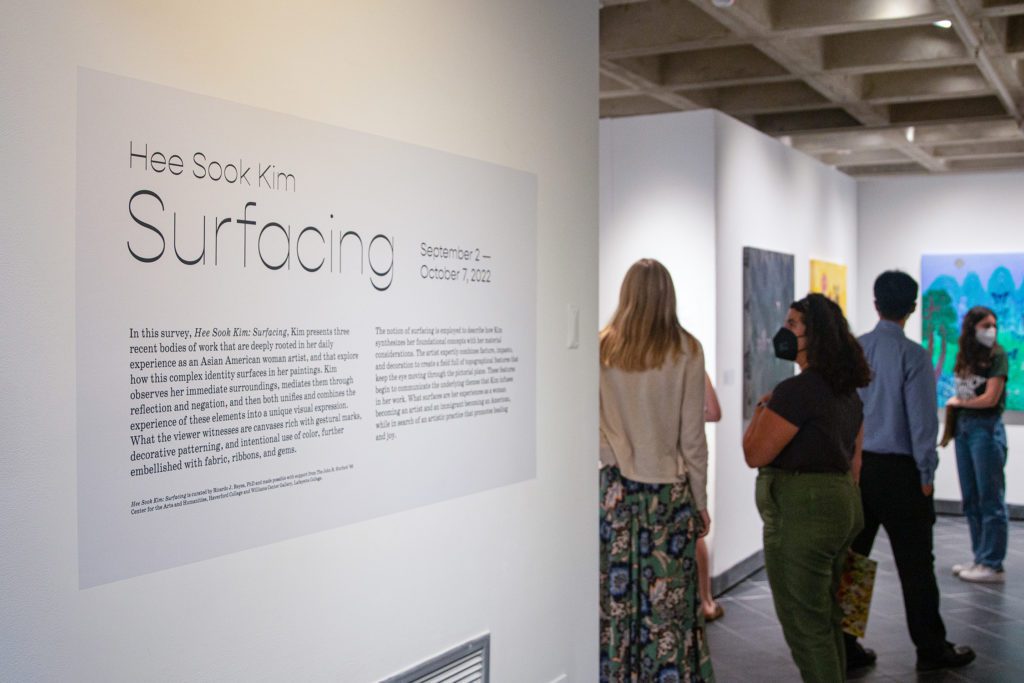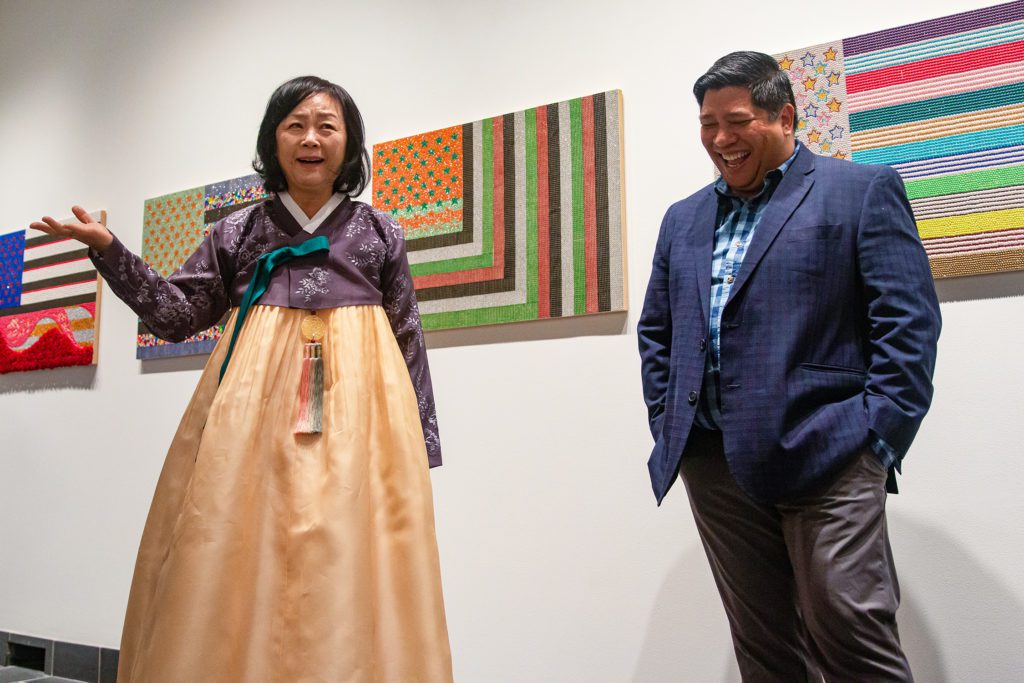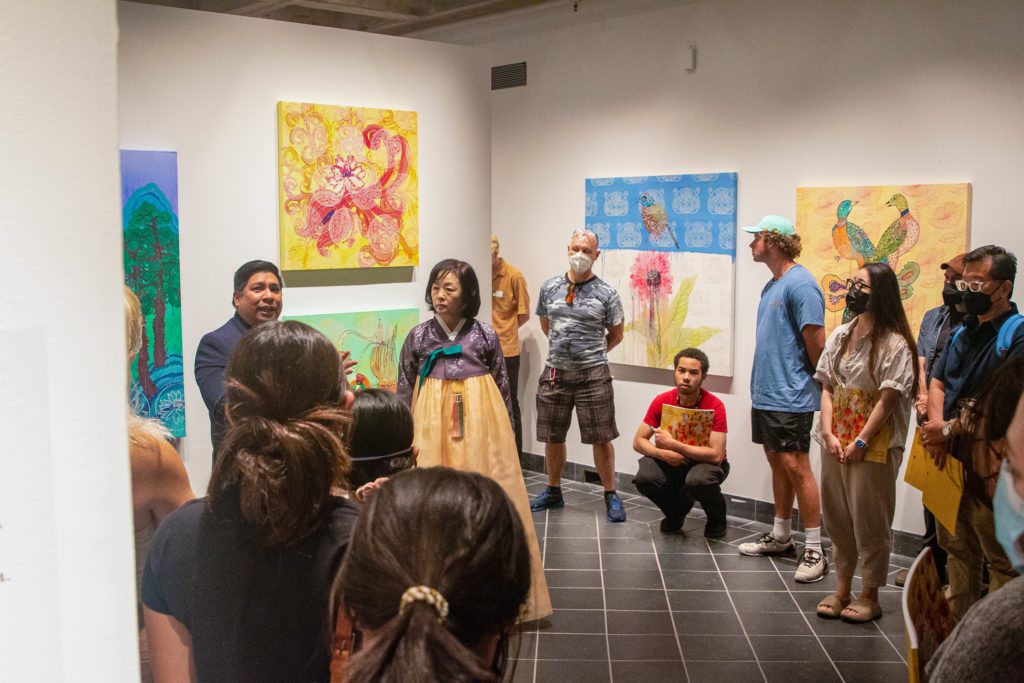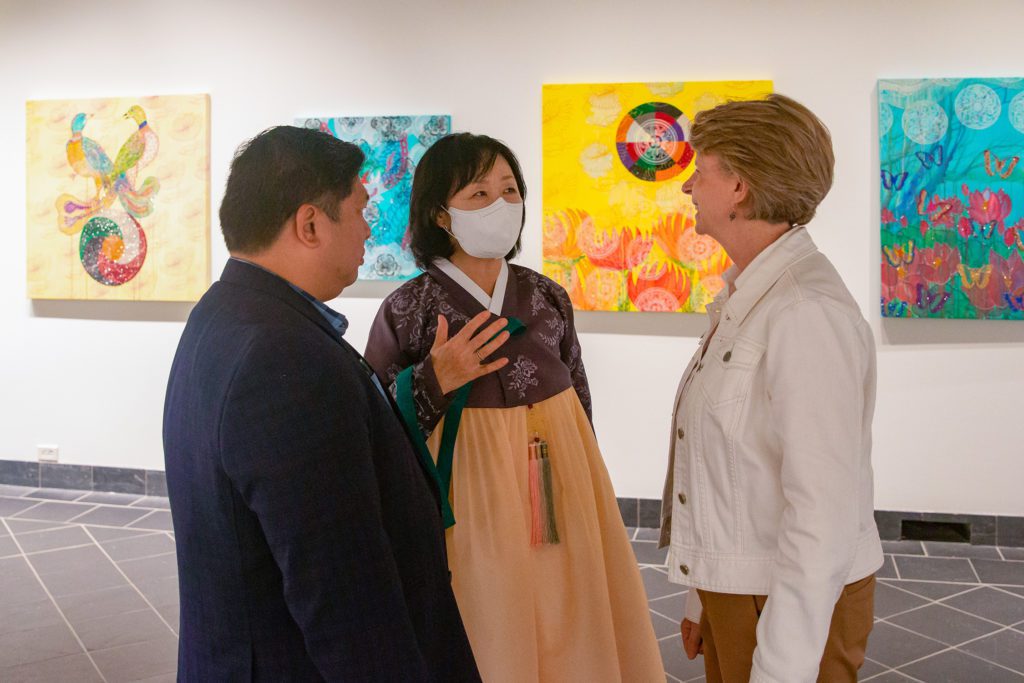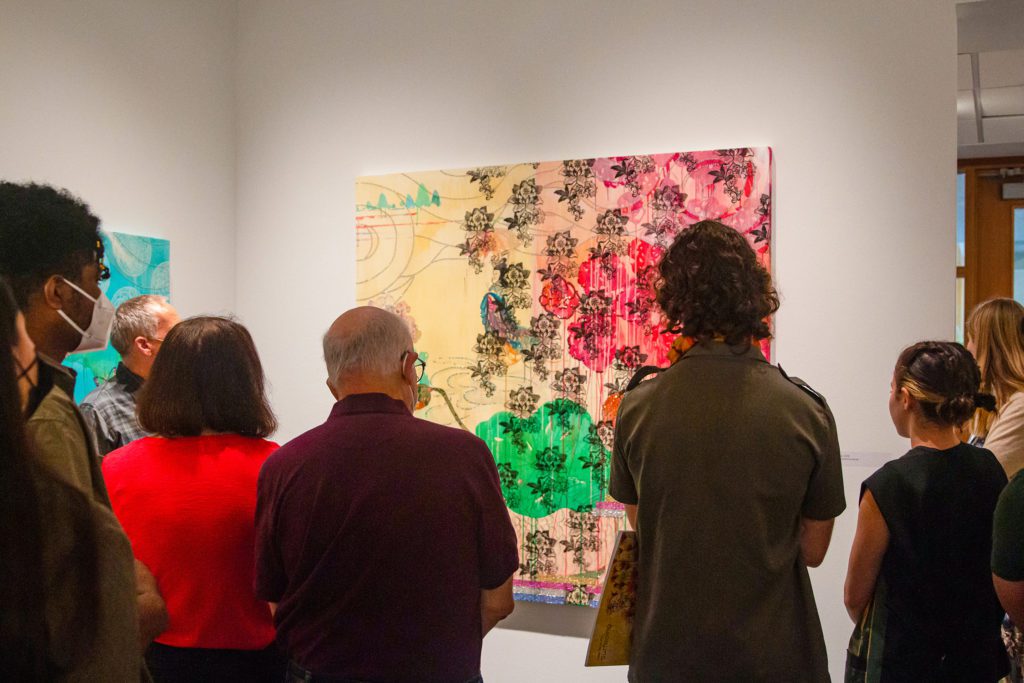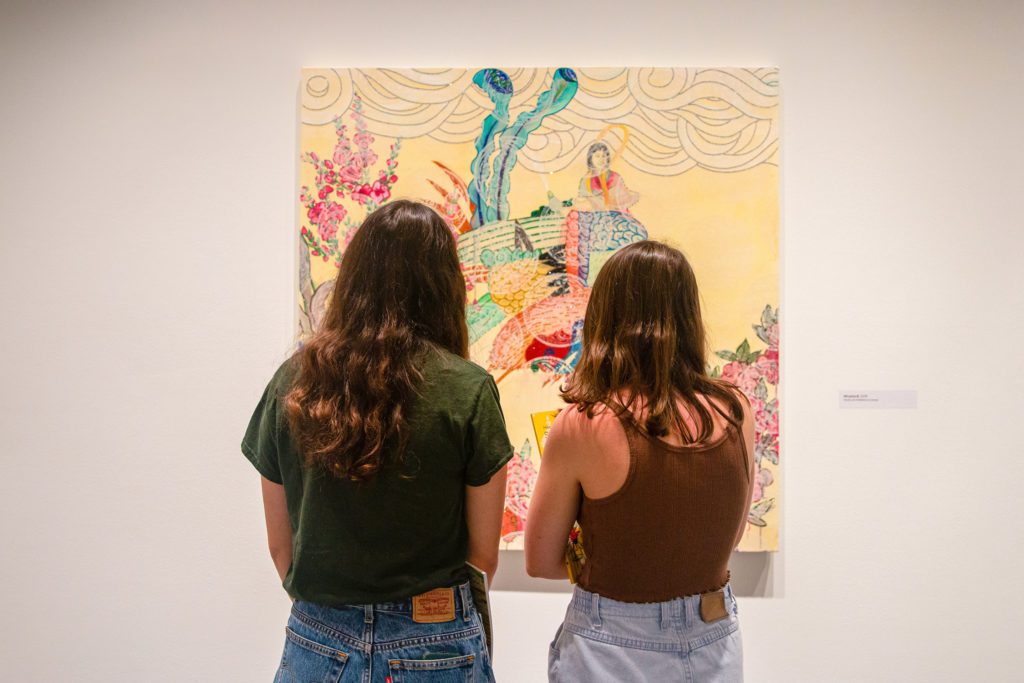Every year, a faculty member of Haverford’s Fine Arts Department displays a collection of their work in the Cantor Fitzgerald Gallery. This year, Professor Hee Sook Kim decorated the space with visual expressions of her experience as an Asian American woman and her struggles and triumphs during the recent global pandemic and national political turmoil. The exhibition, which opened on Sept. 2, was curated by Ricardo Reyes, director of galleries and curator of collections at Lafayette College. Surfacing is also currently on view in Lafayette’s Williams Center Gallery, which is jointly presenting the show this fall. (It will be on view at Haverford through Oct. 7 and at Lafayette through Nov. 18.)
When you enter the gallery, you are immediately greeted by the vibrant color and glimmering rhinestones of the paintings of Kim’s “Nirvana” series, the main attraction of the exhibition’s “Woman as Artist” wing. The Nirvana paintings feature layers of patterns, colors, and rhinestones atop images of nature: animals, plants, and water primarily. The influence of Korean artistic traditions shines through in the work.
“I am inspired by the patterns in old Korean buildings, like Buddhist temples, Hanok (Korean old houses), or palaces,” she said. “My style and colors came from Korean folk paintings.”
Surfacing allowed Kim to reflect on and illustrate the emotional strength she had to adopt in her pursuit of becoming an artist despite the patriarchal limitations she faced in Korea. A few of the paintings in the series contain an image of a woman, which Kim says are “somewhat self-portraits” with face postures modeled after hers. They remind the viewer that personal experiences of womanhood rest at the center of each Nirvana painting, despite the other subjects they portray.
Towards the back of the gallery is a hallway of flags in the “Asian American Patriotism” wing. Titled “My American Flag,” the series features 16 variations on the United States flag, each uniquely customized with materials such as rhinestones, silk flowers, faux pearls, gem fabric, and acrylic nails. Through borrowing the flag form and recreating her own renditions of the stars and stripes, Kim reflects on what it means to be an Asian American woman. Resisting conservative traditions of handling the American flag, Kim celebrates the country’s diversity and reclaims the flag as a symbol for immigrants and women specifically.
“The flags are facing each other like a military formation,” said Reyes. “But the change in materials forces you to think about what the flags are used for, what they represent.”
The third section of work, “The Salve of Synthesis,” is an ode to Kim’s garden, where she worked through her feelings of loneliness and isolation during the pandemic. Her series “Medicinal Gardens” portrays various flowers as tools of healing and symbols of love and hope, backgrounded by colorful settings and decorated with gossamer patterns and gemstones.
While she doesn’t have a favorite piece in this exhibition, there is one that is already especially popular: ”Everlasting Playground,” which was originally a site-specific painting commissioned by the Philadelphia International Airport and hung in Terminal C through February.
The largest piece in the gallery at nearly six-feet tall and 20-feet long, it illustrates vibrant fish, birds, plants, butterflies, and other natural life living in a harmony that reminds Kim of the tranquility of childhood.
The artwork in Surfacing provided Kim an outlet for meditative self-reflection and visual expression during a global hardship.
“It is true that I looked into myself deeper when the creative process moved further,” she said. “During the pandemic period, I discovered myself experiencing the difficult time in the way of healing through art-making,” said Kim.
Associate Director of Cantor Fitzgerald Gallery and Campus Exhibitions Matthew Callinan assisted in realizing the shared vision of Kim and Reyes.
“The process was a collaboration with Hee Sook and Rico that has been ongoing since last academic year,” he explained. “As the curator, Rico really led the project, making several studio visits with Hee Sook and sorting out the thematic structure and work selection for the show, which he also devised as a two-part exhibition between the two colleges. Over the summer we all worked together, alongside other collaborators, to put together the exhibition publication and final exhibition display currently on view.”
Reyes and Kim were connected by their partners, who are both composers, around November 2021. Through constant communication with Kim and spending extended periods of time with her artwork, Reyes identified common themes and intriguing contrasts, which helped him map a narrative for the exhibit in the two galleries.
“The different bodies of work, aesthetically, are quite different,” he said. “You could see Professor Kim’s signature, how she handles paint, how she uses material. The Nirvana pieces are much more narrative. The medicinal plants are still life, and then the American Flag series is really playing with the idea of the flag form. And so that made it another kind of interesting, in their differentiation. For me, the challenge was really trying to make sure that when someone walks in that they understand that these are all Kim’s work, but also understand that these all happen before, during, and after the pandemic. The work has a temporal quality to it, and at the same time it has longer durational universal qualities about healing and patriotism.”
“His vision [for] my work was clear from the beginning, and later evolved even stronger,” said Kim. “I am totally impressed by the way he displayed all of my series [in a way that is] coherent yet powerful in each section, so each work could be viewed in a strong context. You could see the beautiful, strong yet powerful results done by the highly experienced curator.”
With the abundance of work in Kim’s studio during the planning phase, Reyes suggested she do one survey show split between two exhibition venues.
“For me, I think about it as basically curating two different shows in case somebody doesn’t make it to one venue or the other,” he explained. “Then if they only see one show, it will still make sense. That was the first step. Then, we looked at the three bodies of work and figured out which pieces are kind of similar, which are kind of different, and how we could split those up.” About one-third of the artwork for Surfacing is in Lafayette College’s Williams Center Gallery, which will host an artist talk with Kim on Thursday, Sept. 29 at 4:30 pm.
Students admired the way Kim expressed herself through beautiful technique and non-traditional fine arts materials.
“I feel that Professor Kim’s work exudes a delicate and powerful femininity through her use of traditionally feminine motifs like floral patterns, glitter, butterflies, jewels, and even acrylic nails,” said Izzy Ray ‘23. “The way she layers vibrant colors, traditional Korean painting techniques, and dynamic mixed media patterns creates such an uplifting, rhythmic body of work. Walking through this gallery, I truly feel aesthetically and artistically understood.”
“I hope my art has contributed to the Haverford community and beyond in a way of healing, yet clarifying, after such a difficult time, not just including the COVID, but also the social, political turmoil we are experiencing together,” Kim said. “We need to share to learn our differences and work together to get better. I believe in young generations who are open to a better world where we all can live together, understanding each other, as we love our country. That is my American Dream I pursued to come [here a] long time ago.”

